How to Keep Deer Out of Garden (With & Without a Fence, Good & Bad Ideas)
» Deer stories » Deer resistant plants » How to Keep Deer Out of Garden (With & Without a Fence, Good & Bad Ideas)Deer can be a persistent problem for gardeners, causing damage to plants and flowers. In just a matter of minutes, years of careful nurturing and coaxing of a shrub can be destroyed. Bambi wanders over into your garden, chews the flowers to the ground, digs out the bulbs, eats those too, poops on your lawn, then happily jaunts off back into the woods.
This can be enough to make you consider obtaining a hunting license and finding space in the freezer for venison.
As professional deer farmers (and hobby gardeners), we have a good understanding of deer behavior, including what scares or attracts them. This allows us to share some valuable insights and advice on the topic of keeping deer out of a garden.
contents:
Disclaimer: aside from invaluable knowledge and humor, this post also contains some Amazon affiliate links. We collect rewards from qualifying purchases, but it won't cost you an extra dime!
While a high solid fence is the best option for keeping deer out, not everyone has the means to build one or wants to alter the appearance of their yard. There are several other strategies you can use to deter deer from entering your garden without relying on a fence, a few of them are bad ideas, but we're going to explain what works and doesn't and why that is.
1. Scare tactics
Use deer deterrents 👎👍
There are several devices you can use to keep deer away from your garden, such as motion-activated sprinklers, noise-making alarms, and flashing lights. These deterrents use sudden movements or noises to startle deer and make them wary of approaching your garden.
It would seem, it's a good idea: just spook the deer away. But the problem is that a scared deer is like a psychiatric institution resident off his meds. Basically, here's why:
Why did the deer jump into the window, instead of run away where it came from - we'll never know. Only we've seen this odd behavior many times with our deer. Perfectly free to run in 3 other directions, the panicking animal throws itself at the fence, sometimes rolling around it, landing on the other side, sometimes getting tangled in and trying frantically to free itself, other times breaking its neck.
If you think your space arrangement is much safer for a panicking deer to navigate, with nowhere to get caught up in, - go ahead, try sprinklers.
Here’s one of the models sometimes recommended for this purpose Orbit 62120 Garden Enforcer Motion Activated Sprinkler
It’s also got positive reviews from verified purchases.
We would appreciate your feedback on their effectiveness if you end up buying them!
Quick and dirty deer-scare tricks that work temporarily. You can prolong their effectiveness by rearranging and rotating.
- Move around your outdoor furniture, garden gnomes, add a few pink flamingos at the garden's edge, or create scarecrows and move them around weekly to monthly. Even familiar objects in new locations or new angles can spook deer.
- Unusual objects like reflective tapes or CDs can be used to scare deer away by tying them to trees or shrubs. Anything that moves can be scary to deer if it's something they haven't seen before, such as a towel hanging on a clothesline.
We once left this this long, thick water pipe/hose on the ground in one paddock and deer were avoiding it like it was a scary predator, perhaps it resembled a snake to them. About a week later though - stepping over it because they knew it was nothing. On our farm, deer have been scared of many new things, like umbrellas, linens on the line, soap bubbles...

Can dogs scare deer away? 👎👍
Coyotes and wolves, relatives of domesticated dogs, are natural predators of deer. It is believed that deer are intimidated by their similarity to these wild dogs, even if the domestic dog itself is not actively hunting or pursuing them. Additionally, wild dogs have been known to prey on deer, further adding to their instinctual fear. These factors may contribute to deer being scared away simply by the presence of a domestic dog.
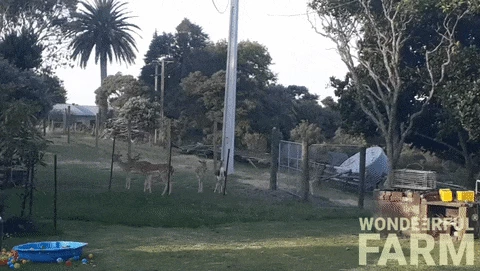
For this to be successful though the dog needs to often be present in the yard you want to protect.
This, however, carries a risk of a dangerous interaction between the two species that don't mix well. See our post Dog chases our deer. Deer - dog fights have taken place and in many instances dog suffered life-threatening injuries. Yes, Bambis can kick! Most of the time deer prefer to flee though, but during the rut they can become more aggressive.
Another drawback of this idea may be that barking, sometimes at night, when deer can be very active, could be unpleasant to your neighbors and yourself. But theoretically, deer should stop coming when they learn your area has been occupied by a frightening beast.
Nighttime predator lights
While researching this plant we're about to start from seed and whether it was deer-resistant, we've come across people recommending these interesting devices on Facebook. Then googled and found them being sold online + more good reviews.
The solar-powered red lights imitate the eyes of large predators at night. Built to scare away coyote, deer, wolf, fox, racoon, skunk, owl and other nocturnal wild animals. Aside from being humane, they also look kind of cool and don't cost a fortune.
This is just one of the highly rated products like these that is - at the time of writing - on discount Redeo Solar Nocturnal Animal Repeller. (Tessa's review pictured above is for that same product.) According to other reviews on that page, there is actually no motion sensor, they seem to keep the same flash continuously throughout the night. But that may be good thing with deer as you've seen how badly they can react to being startled. Better to just give them a fair warning straight away so they don't even try to approach.
If deer mainly attack your property at night - 'predator eyes' devices may be just what you need.
2. Stinky repellents tactics
Use deer repellent on the plants 👎👍
You can find many different types of deer repellents on the market, including sprays, granules, and stakes. Some contain spicy or bitter flavors that deer don't like, while others release an odor that deer find unpleasant.
If no other option is available to you, or as a temporary solution, it doesn't hurt to try the deer repellent option as it's quite inexpensive. Hopefully, if the deer have equally good food options elsewhere, and you start spraying your plants thus making them less appetizing, the herd will move on to the better pastures (your poor neighbour's) and forget about your backyard. But don't be surprised if they come back in a month.
Some of the deer repellents contain ingredients like putrescent whole egg solids, garlic, or hot pepper, and you can make one at home. Overtime deer may get used to these repellents and begrudgingly eat the odd smelling/tasting plant anyway. Use a different concoction from time to time to prevent deer adapting to the same repellent formula.
Reapply repellent after rainfall. Cover your whole plants from the ground and extend upward at least six feet.
During winter, scent-based deterrents may not be as effective due to the cold weather inhibiting the dispersal of scent. Additionally, the need for frequent reapplication of these deterrents may become inconvenient and wasteful due to frequent rains and snow.
What do studies show?
The study titled "Effectiveness of deer repellents in Connecticut", conducted in 2010 by JEFFREY S. WARD and SCOTT C. WILLIAMS, compared the effectiveness of different deer repellents on yew plants, with a focus on both pen and field studies, and rates them based on the degree of protection they provide relative to untreated plants.
No single repellent was 100% effective, and egg-based products tended to be the most effective. Bobbex and Hinder were the two most effective products. Liquid Fence, Chew-Not, and Deer-Away Big Game Repellent also provided good protection, and Thiram and Hinder were more effective in field than in pen studies.
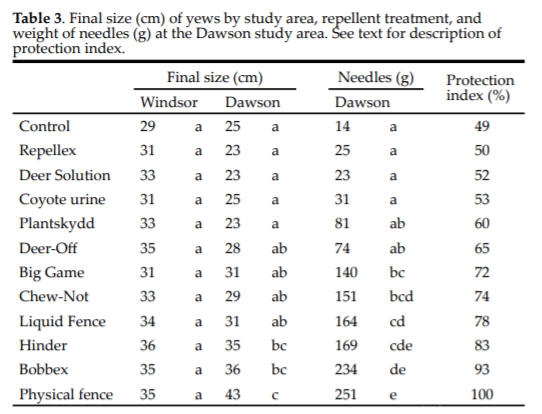
Overall, the study found that repellents can provide protection approaching that of a physical barrier such as a fence, and the most effective products required the most frequent application.
Does coyote urine repel deer?
According to the study linked above, coyote urine does piss-poor job at repelling deer. The study found that while urine and blood-based repellents were somewhat effective in short-term pen studies, they were less effective in field studies. Therefore, it seems that coyote urine was not very effective in reducing browse damage in the field.
🤢 Does human hair protect your garden from deer?
Human hair has been reported to be effective in keeping deer away from plants. The strong odor of human hair is said to be unpleasant for deer, and they will typically avoid areas that smell strongly of it. This is why many gardeners will place strands of hair or hair clippings around their plants to keep deer at bay.
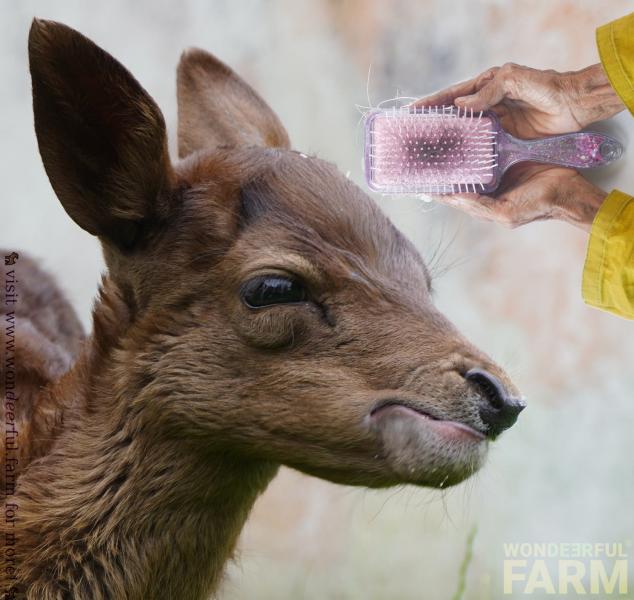
It's worth noting that the effectiveness of human hair as a deer deterrent can vary depending on the deer population in your area and other local factors. Additionally, while human hair can be an effective deterrent, it's not a permanent solution, as the hair will eventually degrade and lose its potency over time. So, you may need to reapply it regularly in order to maintain its effectiveness. We have obviously not tried this gross method ourselves because our deer are used to human scent anyway and associate it with treats more than danger.
Does Irish soap keep deer away?
It is rumoured that if you hang a bar of Irish Spring soap along the perimeter of your garden or spread some soap bar shavings around your yard it will help keep drive away not only deer, but also rats and skunks.
3. Planting deer-resistant varieties, companion planting 👍
One of the easiest and ecological ways to keep deer out of your garden is to choose plants that they don't usually find appealing. However, there are but a few species of plants that are less likely to be damaged by deer, including hyacinth, freesias, coneflower, nasturtium, bigleaf hydrangea, ornamental onion, bearded iris, and yarrow. See our Deer Resistant Plants section for reference.
Be warned that while deer certainly have their food preferences and love some plants more than others, when times are hard they’ll eat nearly anything. Still, if you plan your garden to be composed of plants deer consider least appetizing your backyard will be statistically less likely to be visited by deer.
There are deer-resistant garden plans available
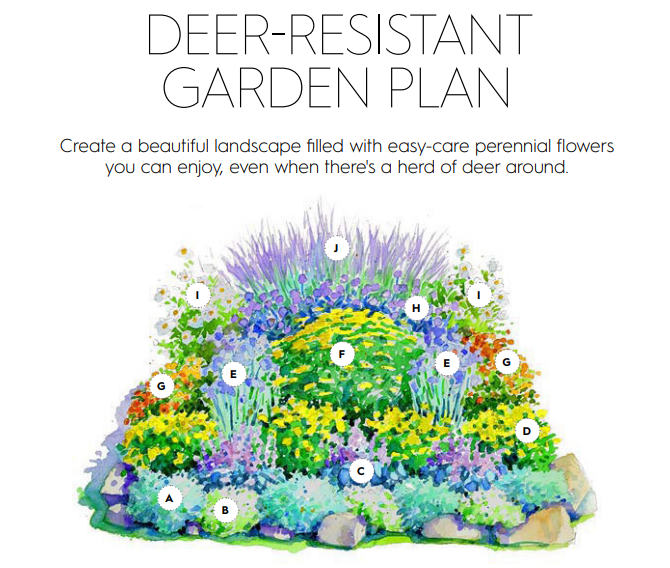 for example https://static.onecms.io/wp-content/uploads/pdfs/sites/37/2021/01/14/bhg-deer-resistant-garden-plan.pdf
for example https://static.onecms.io/wp-content/uploads/pdfs/sites/37/2021/01/14/bhg-deer-resistant-garden-plan.pdf
You can also try companion planting of fragrant herbs like lavender, mint, basil or rosemary near your deer-vulnerable plants to help hide their aroma. Deer tend to shy away from strong scents. They also dislike the texture of woody plants like lavender and Russian (Perovskia) sage. But you would have to plant a lot of deer-repelling plants in order to cloak the enticing smells coming from your other greenery. Remember, deer possess a very sensitive sense of smell, it takes a lot to fool them.
We have this impatient flower that is never bothered by deer and it is literally growing in the sea of mint to it's right and left. Mint is invasive and it just hapenned. And it works, but it doesn't look as beautiful.
Basically, you want to grow deer-favorite plants close to the house and plant pungent perennials as a natural barrier.
4. Physical barriers: fencing, hedging, netting etc
Will bird netting keep deer out? 👎
Deer are muscular and surprisingly strong animals that can push through or jump over or even sometimes chew at plastic/fabric netting, causing more damage to your plants in the process.
They can be quite cunning when the only thing that is separating them from their lunch is a bit of thin, somewhat stretchy matter.
Here's a short story of a deer and a loose fence:
Notice how high the fence is though in relation to deer's body. This is the fence they can't jump. (Not that they wouldn't try at the time of desperation, they try to walk through walls when they're in panic mode).
Our deer have also broken into things before to get to food, in our post How cunning buck must-ve kicked the bucket we shared a story like that.
Fishing line fence to keep deer out of your garden 👎
Using fishing line to keep deer out of your garden is not a recommended solution, as it can be dangerous for the deer. Fishing line fences can be invisible to deer, and they can easily get entangled in it as they move through the garden. This can lead to serious injury or even death, as the deer may become trapped and unable to escape. Such fence can also become a death trap for birds like owls.
Dense hedging against deer 👍
To deter deer from entering your garden, you can try planting large and sprawling deer-repellent plants such as dense boxwood hedges or low-growing needle spruces along the perimeter of your garden. By obscuring their view, deer are less likely to venture onto your property if they cannot see what's inside. Privet is usually so deer proof that it can be used as a living fence around gardens, like in the following foto:

Create levels to deter deer 👎👍
You can deter deer from entering your yard by adding levels to your landscape. Deer aren't avid climbers, and a yard that appears difficult to navigate can be a deterrent to them. Adding features such as sunken beds, terraces, and stacked firewood can motivate deer to go searching for easier food sources elsewhere.

Image Source: Öljylautta Public Domain
One drawback of stacking pallets or firewood around your property is that if deer visit with their recently born tiny fawns, an odd one might get stuck in them. One of ours once fell in between some chopped wood and was crying, unable to break free, with doe running frantically around him. We've rescued him, of course, but he and his mother were quite shaken up that time.
Keeping potted plants on a deck or porch, deer are unlikely to attempt to climb stairs.
Our deer have been by the house many times but they're wary of walking up the steps to get on the deck.

Erect a proper deer fence 👍
A solid deer fence is typically 6 to 8 feet (~ 2 meters) tall and made of sturdy materials that can withstand deer pushing or jumping against it. Some common materials used to construct deer fences include:
- Wood: A solid wood fence, such as a cedar or redwood, can be effective in keeping deer out of a garden. It should be at least 6 feet tall and should be constructed with close-fitting boards to prevent deer from pushing through the fence.
- Metal: Metal fences, such as aluminum or steel, can also be effective in deterring deer. They should be at least 6 feet tall, have tightly spaced pickets to prevent deer from pushing their heads through to reach the plants inside.
- Vinyl or PVC: These materials are weather-resistant and easy to maintain, making them a popular choice for deer fencing. They are often available in pre-made panels and can be up to 8 feet tall.
In conclusion.
Deer are known for having a powerful sense of smell, being muscular and strong, having the ability to jump nearly 2 meters high, and being cunning enough to push through feeble fencing, which makes them dangerous pests in a garden. In order to effectively keep them out, it is ideally recommended to erect a solid, 2 meter (6 to 8 feet) high fence around the garden as this is the only method that will provide complete protection against these resourceful and determined animals.
Barring the fence option, you can try planting deer-resistant varieties, using dense hedges, deer repellents, installing deer deterrents, or trying companion planting. Trimming tall grasses can prevent deer from using the area for bedding, and harvesting fruits as soon as they are ripe and promptly removing any crops after harvest can reduce the food supply that deer are attracted to. By making your garden less appealing to deer, you can reduce their visits and protect your plants.
Since deer can quickly adapt to different deterrent methods, a single approach (unless a solid fence) is unlikely to be effective in keeping them out of your garden. To prevent deer from learning that your garden is a good food source, it's important to use a combination of deterrents and change them regularly. Even if you don't currently see deer in your area, it's best to start using deterrents before they discover your garden. Make sure to use multiple deterrents at once to keep deer on their toes and prevent them from becoming accustomed to any one method.
Last modified 01 December 2023 at 15:24
Published 11 February 2023

Wondeerful Farm
Hi Kay!
That's a tough one. In our farm setting, deer don't come across glass windows so we don't have experience to share on that particular situation and so below is just my speculation.
You're thinking reflection can trigger it, but there are also terrifying videos of deer jumping through perfectly see-through glass, likely because they can't see it at all when they're running scared.
For protection against deer charging into windows, laminated glass or polycarbonate sheets are often recommended due to their ability to absorb impact and prevent shattering. This is an expensive solution which a glass specialist should know more about.
Assuming you don't want to install a fence or window bars or plexiglas, I guess this leaves you with options like glass film/stickers?
Something you can glue onto the surface that will make the glass:
- visible for the animal
- prevent deer from seeing its own reflection.
Perhaps only covering the bottom part, up to an average buck's height. By stickers I mean something like privacy film https://amzn.to/47pQ2yx or even some Christmas decor https://amzn.to/3uu9NXf or other themes.
If you wanted to go for a 'scarecrow' approach, you could try and hang a few mylar balloons and/or mylar tape that move when the wind blows.
The majority of incidents involving deer crashing through windows occur during mating season (the rut), where a male deer, upon seeing its reflection in glass, perceives it as a rival and charges. But that is over now in In the Northern Hemisphere (August-October). So hopefully you're "out of the woods" by now.
Obviously, avoid feeding deer or leaving food near the house and ask your neighbours to do the same.
Hope this helps and that deer in your area behave!
Add your comment
More «Deer resistant plants» stories
Do Deer Like Agapanthus? African Lily Deer-resistance.
Do deer eat agapanthus plants? What's more deer resistant: Lilly of the Nile or Ornamental Onion? Similiarities and differences between the two perennials. Recommendations to gardeners struggling with deer damage.
read more...
Purple toadflax (Linaria purpurea) a deer proof plant?
For some inexplicable reason, deer just can't seem to get on board with purple toadflax, so if you're tired of deer munching on your garden plants, purple toadflax might just be the solution you've been looking for.
read more...
Is Heuchera deer resistant? Do deer eat Coral Bells?
Testing Coral Bells AKA Heuchera the Fire Alarm variety for deer resistance. Do deer like to eat Heuchera's beutiful red foliage?
read more...
 '
'
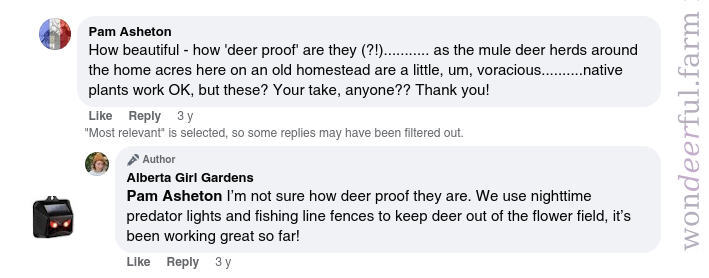



Kay 23-11-2023:
How do we keep deer away from our front window? I’m afraid they’re going to charge it because of the reflection. It’s about two feet off the ground. Thanks.